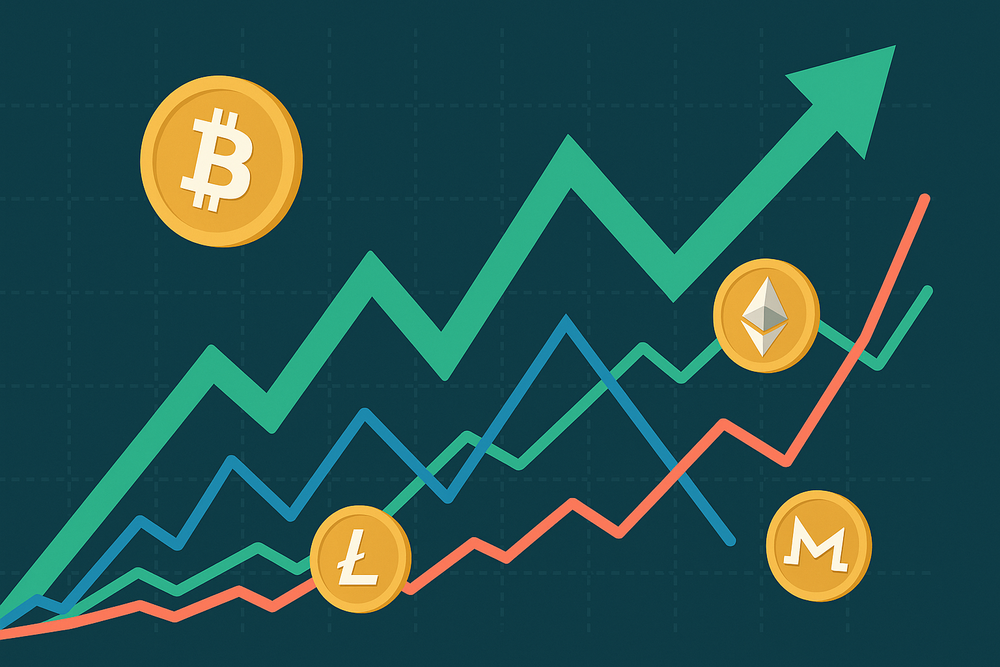Bitcoin News Today: Institutions Bet Bitcoin Could Replace Dollar as Reserve Asset by 2035
- Analysts predict Bitcoin could hit $1.3M by 2035 as institutions increasingly adopt it as a hedge against monetary devaluation. - Bitwise's report highlights Bitcoin's limited supply and declining inflation rate, contrasting it with gold and projecting 28.3% annual growth over a decade. - Early investors' selling pressure and regulatory uncertainty pose short-term risks, though long-term demand from $100T institutional assets could drive massive adoption. - Macroeconomic shifts, including reduced dollar
Bitcoin price could top $1m thanks to institutions, analysts say
Bitcoin’s long-term price trajectory has drawn significant attention from institutional investors and analysts, with some forecasts suggesting the cryptocurrency could reach an unprecedented $1.3 million per coin by 2035. Bitwise Asset Management, a leading crypto asset manager, released a report outlining a compelling investment case for Bitcoin as a hedge against monetary devaluation and a potential cornerstone in diversified portfolios. The report estimates a compound annual growth rate of 28.3% over the next decade, with an average volatility of 32.9%. It further projects that institutional investors could allocate between 1% and 5% of their portfolios to Bitcoin, which, given the $100 trillion in assets under management by these institutions, could translate into $1,000 to $5,000 billion in demand for the asset.
Bitwise’s thesis centers on Bitcoin’s role as a digital store of value amid concerns over perpetual monetary devaluation. The firm aligns with views expressed by prominent investors like Ray Dalio, who argue that countries with excessive debt are likely to pursue policies that devalue their currencies. The U.S., for example, has seen its debt balloon from $650 billion in its first 200 years to $36.2 trillion today. Bitwise’s analysis suggests that as the dollar’s dominance in international exchange reserves wanes—partly due to shifts in global economic power—Bitcoin could become a preferred reserve asset, especially as more governments consider incorporating it into their foreign exchange holdings.
The report also highlights the limited supply of Bitcoin, currently at 19.9 million out of a maximum 21 million, with annual inflation rates declining over time—0.8% in 2025, 0.4% by 2028, and 0.2% by 2032. This scarcity model is contrasted with gold, which has an annual inflation rate between 1% and 2%. Bitwise’s most optimistic scenario envisions a price of $2.9 million per Bitcoin by 2035, which would imply an annual appreciation rate of 39%. The firm’s projections have already seen early signs of validation, with Bitcoin ETFs holding $170 billion in BTC as of now.
Despite these bullish forecasts, analysts have also noted factors that may slow Bitcoin’s price ascent in the short term. Willy Woo, a well-known cryptocurrency analyst, pointed to the influence of early investors who acquired Bitcoin at much lower prices. These “OG whales” hold a substantial portion of the supply and are selling at a pace that requires significant capital to absorb, thereby limiting upward price momentum. In contrast, Parman, another market observer, argued that these early holders are unlikely to dump large amounts of Bitcoin, limiting the market impact of their sales.
Institutional adoption and regulatory developments remain key drivers of Bitcoin’s price movements. Clearer regulatory frameworks in certain jurisdictions have led to increased adoption, while regulatory uncertainty or crackdowns in others have caused price fluctuations. Additionally, Bitcoin’s price is influenced by broader macroeconomic trends, including inflation, interest rates, and the global shift away from the U.S. dollar as the dominant reserve currency. As countries like China and Russia reduce their reliance on the dollar, the demand for alternative stores of value—such as Bitcoin—could grow.
The evolving landscape of Bitcoin-related investment vehicles also plays a role in shaping its price dynamics. While some firms have adopted a “Bitcoin treasury” strategy—buying and holding large amounts of the cryptocurrency—investors must be cautious about the financial engineering behind such strategies. These companies often raise capital through convertible debt, equity issuance, and warrant structures, which can introduce risks of share dilution and leverage. As a result, their stock prices may not always move in direct correlation with Bitcoin’s price, leading to potential mismatches between investor expectations and actual outcomes.

Disclaimer: The content of this article solely reflects the author's opinion and does not represent the platform in any capacity. This article is not intended to serve as a reference for making investment decisions.
You may also like
Investors Chase AI Growth as Nvidia's Ecosystem Takes Center Stage
- Nvidia's Q2 2026 revenue hit $46.7B, driven by $41.1B in data center sales and full production of its Blackwell AI platform, despite slightly missing analyst forecasts. - Strong AI ecosystem growth fueled 35.7% gains in leveraged ETFs like RIOX and ETHT, as Fed signals of rate cuts boosted market optimism for AI sector exposure. - AI ETFs such as BOTZ and ARTY hold NVIDIA as top holdings, reflecting its central role in AI infrastructure as partnerships expand across Europe, the Middle East, and major cli

Pump.fun's Aggressive Buybacks Signal New Era in Crypto Market Intervention
- Pump.fun repurchased $58.13M PUMP tokens by August 26, reducing 4.261% of circulating supply. - The $10.66M weekly buyback (99.32% of revenue) reflects aggressive market intervention strategy. - Crypto platforms increasingly adopt buybacks to stabilize token economics and investor confidence. - Despite efforts, token price remains unchanged amid crypto market volatility and competitive pressures. - Success depends on sustained execution, transparency, and alignment with broader strategic goals.

Metaplanet's Bitcoin Treasury Strategy: A Catalyst for Institutional Adoption in Asia
- Metaplanet, a Tokyo-listed firm, raised $880M via share issuance to buy 18,991 BTC, becoming the fourth-largest corporate Bitcoin holder globally. - The company's strategy combines Bitcoin accumulation with covered call options, generating ¥1.9B in Q2 2025 while hedging against Japan's weak yen and negative interest rates. - Regulatory shifts in Japan and growing Asian institutional adoption (e.g., Hong Kong's Ming Shing Group) signal Bitcoin's emerging role as a reserve asset in corporate treasuries. -

Hunting in Contradictions: Saying Goodbye to Narratives, Embracing Volatility
